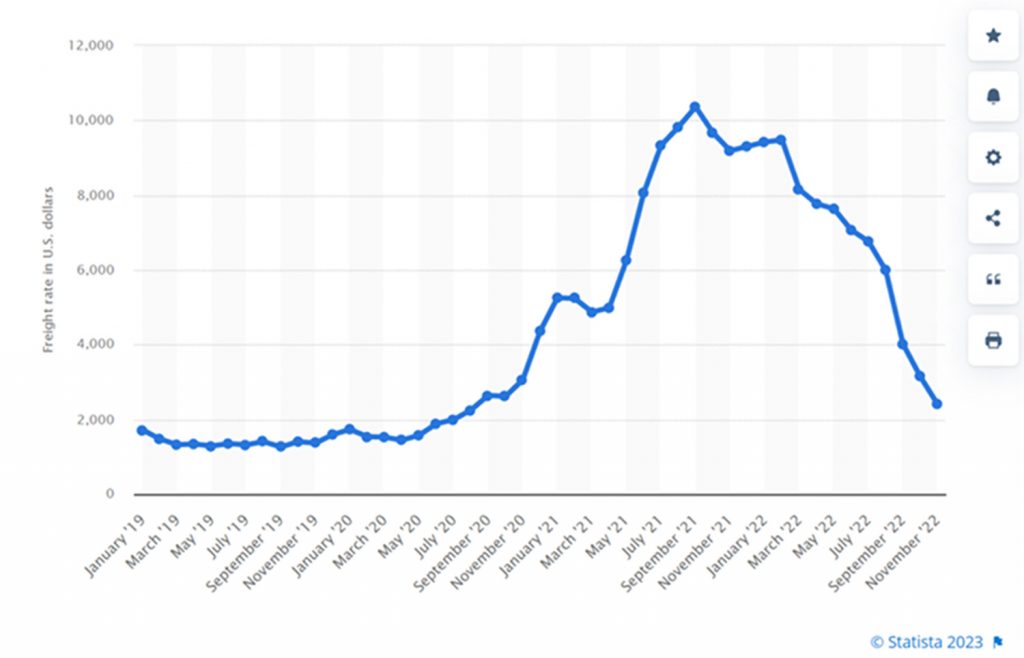
By Nate Cory, Chris Lange
Introduction
In today’s dynamic and unpredictable economic environment, few categories have seen more immediate turmoil and disruption than global Ocean and Air transportation services. In a complex web of geopolitical circumstances and market conditions, the global ocean and air sourcing environment is experiencing a generational “buyer’s market”. When delay can be worth millions of dollars, there’s never been a time more ripe for addressing this critical area of operational expense. There’s also never been more pressure to get it right.
What does it mean to get it right?
- Think strategically
- Execute and substantiate sourcing savings
- Optimize time to value
Want to learn more? Read on…
Defining a “Buyer’s Market”
So why is now such a great time to think about renegotiating/re-addressing your organization’s ocean/air transportation services?
For starters, you spend a bunch of money on it. Top global manufacturers and distributors spend a significant amount of money sourcing Ocean/Air transportation, and that spend inflated massively during the Pandemic due to supply chain disruptions. Sourcing decisions in such areas have increasing influence on bottom line performance.
There’s also the Ocean/Air transportation market itself. Whether it be the current, rapidly declining prices in the adjusting post-Pandemic market, or the dissolution of major global shipping alliances (e.g., 2M Alliance: Maersk & MSC), carriers are looking to fill ships and planes and maintain market share. Negotiating leverage has never been stronger. As such, Impendi is seeing impact in these categories of between 60-80%+ without disrupting supply chain performance.
Global container freight rate index from January 2019 to March 2023 (in U.S. dollars)

Challenge: The problem with “I got this”
While most global organizations are currently thinking through or acting on these sourcing decisions, the real questions arise:
Are you thinking strategically? Everyone that addresses these categories are going to save money, but have you thought about all facets of the currently adjusting market; as examples:
- Are you decoupling the ask of providers or negotiating through-rates.
- How are you de-risking your portfolio for:
- Geographic considerations?
- Carrier Alliance diversification?
What’s the cost of not thinking strategically? There are a magnitude of timing considerations to savings. While often business case analysis (and subsequent negotiations) battle for the highest savings percentage, speed to execution can be equally critical. A six-month delay in negotiations negates a half a year of in-year savings. An extra 10% of savings in a mishandled negotiation for spend of this magnitude could be worth millions. Knowing how to efficiently execute an RFP/Market ask and how long negotiations can/should be drawn out are critical points of context.
How are you thinking through your options? The sheer number of evaluated options/scenarios in this category can be daunting. Companies employing specialty technology to assist in the effort to renegotiate their contracts can manage the many combinations and permutations of looking at significant numbers of alternative scenarios to quickly come to a workable solution – often getting maximum results in minimum time. Examples of common scenarios evaluated include:
- Absolute least cost scenario
- Least cost with incumbency weighting
- Least cost including sustainability objectives such as least carbon emitted
- Least cost with fastest service
- Solutions in which various stakeholders can buy-in (Geographic or Business Unit agreement, etc,)
- Understanding the piece parts and stitching together a solution
Conclusion: Too important to overlook or delay
Global sourcing and operations must understand and answer this urgent call to action. Not executing in a less than timely manner is a thoroughly missed strategic opportunity. In this dynamic market, Impendi is achieving savings of 60-80% (20-30% better results than what our clients were able to achieve on their own).
If you or your organization is currently navigating similar issues and want an immediate external SME perspective, please reach out to our Logistics Center of excellence team at the following link.
Want to learn more? Please contact Impendi.





